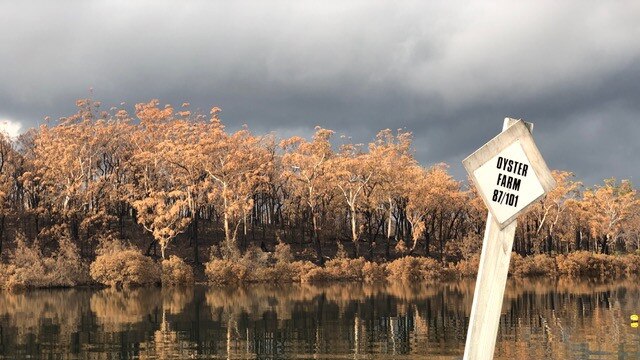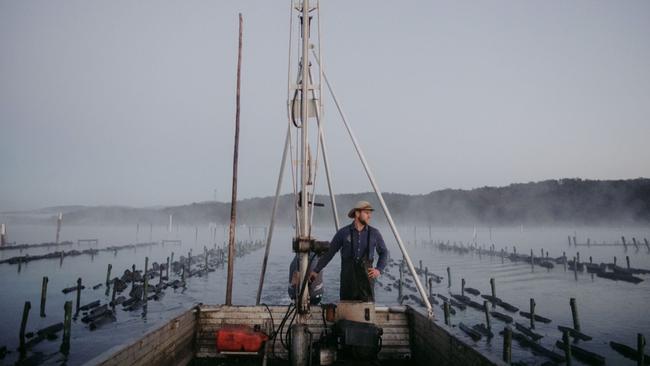Coronavirus: Batemans Bay oyster farmers dealing with new challenge after bushfires
On the NSW south coast, the baskets are full and the oysters “look incredible”, but thanks to the coronavirus crisis they’re not flying out the door fast enough.

The South Coast News
Don't miss out on the headlines from The South Coast News. Followed categories will be added to My News.
After bushfires and a deluge of rainfall suspended many south coast oyster farmers’ harvests over summer, they were ready to flood restaurants and fish shops with their full baskets.
After bushfires and a deluge of rainfall suspended many south coast oyster farmers’ harvests over summer, they were ready to flood restaurants and fish shops with their full baskets.
Yet now they’re forced to find new ways to market their products and deal with fluctuating demand due to COVID-19 restriction measures.
“It's a funny thing right now, actually, because oysters look incredible. We were so excited after the floods finished,” Jase Finlay, who farms Sydney rock oysters on the Clyde River in Batemans Bay, said.
“We're just bursting at the seems with incredible oysters ready to sell and we're going to have our baskets too full because we can't we can't get them out the door quick enough with the virus now shutting down all the restaurants. It’s such a weird thing.”
About 80 oysters farms are operating between the Shoalhaven River and the Victorian border. In January, Shoalhaven, Clyde, Tuross and Narooma estuaries were closed for a short-time due to higher readings of contaminants.
Logistics challenges due to road closures and a tourist exclusion zone in what would be the busiest time of year for sales also impacted farmers’ bottom lines. The deluge of rainfall in early February then halted harvest for five more weeks on the Clyde River.

“The major stress of the fire had passed but here was a bit of talk about each river or estuary being affected by O2 [oxygen] changes from all the ash entering the river and changing the changing the pH and O2 [oxygen] levels, which could can be pretty devastating to all marine life oysters as well,” Mr Finlay said.
“And the Clyde river was burned so substantially that with flood rain coming we thought for sure we could be in a spot of bother.
“So I guess it was a heightened stress period for a long time and with that rain then comes closures to the river in its own right, which actually ended up lasting five weeks where you we weren't allowed to harvest and sell from the river.”
While he didn’t have “widespread” oyster deaths due to flooding, there was still “a big chunk of mortality”.
They’re still in the process of receiving government support.
“Luckily, they [oyster mortality] can be documented through the systems we have, which has helped us in the process and it does seem that we will get help, but the government systems are a little bit set up for agricultural farming,” he said.
“So it's been a bit of back and forth to work out exactly how we can provide all the information needed when it's tailored to agriculture, but definitely, we've had a lot of help.
“It's looking promising that we will get support. I think we're going to be fortunate that we will get enough support to keep our staff employed to some degree and keep things keep things moving.”

Mr Finlay acknowledges that it is a “pretty stressful time” but, he says Clyde River farmers are resilient and will work together during another crisis.
“The talk is that sales have just not come to a dead halt but close to and maybe that's just this initial hit until everyone works out ways that it can be done. I haven't heard anyone talking negatively. It's all just like ‘let’s band together, let's work out a way to do this’.”
One way is to encourage the public to purchase home deliveries, rather than seeing the molluscs as a luxury item only to be eaten when dining out or on special occasions.
“With all these changes, we're just going to adapt and work out a way to keep things ticking along,” he said.
“I've got a marketing company which we work closely with and that was always going to 60 restaurants a week, so that had stopped overnight, but we're kind of restrategising on how we can celebrate seafood straight to people's doorsteps.
“We're helping people be aware that it is such a healthy, fresh thing that could be at their doorstep and it could be almost an almost a staple of good vitamins and minerals rather than thinking it's just a treat at a restaurant.”
On the Sapphire Coast, Mimosa Rocks oyster farmer John Blankenstein says producers from Bermagui to the Victorian border faced similar closures.
Just as producers were “getting their heads out of the smoke” they were dealt another blow by mother nature, with rainfall affecting the all of the catchments south of Bermagui.
“You know, you got that emotional roller coaster of coming out of [the fires] and thinking now is the time to salvage, let’s get into it. Then you’re dealt with another blow, and it’s like ‘OK, how can I work around that’

As an owner-operator who farms on Nelson and Wapengo lakes he changed his harvest schedule, working through the night, as he expected closures to be in place the next mornings.
“Drastic times calls for drastic hours of work and measures,” he said.
Like Mr Finlay experienced, a small window of sales opened up. But, COVID-19 restrictions have had a major impact on sales coming into the Easter break.
“Obviously the rain subsided and we just started to get some really good traction again, there was consumer confidence again, people were out spending money.
“Easter is probably one of the most productive times for Far South Coast oyster farmers. We’re not dealing with competition from north coast farmers and our estuaries are the best as this time.”
With an instant shutdown of restaurants, wholesale business stopped. Primary producers aren’t the only businesses looking to be innovative to maintain income though.

“Restaurants are closing, but some are selling takeaways. Florists are selling fruit and vegetables and there’s a crazy premise that Maccas is selling essentials,” Mr Blankenstein said.
“I think we really need, as a nation and as an industry, [to] strongly look at where we are now, how we got to this point and where to from now. As much as there is, you know, a lot of negatives, there are potentially a lot of positives that can come out of it.”
Like agricultural farmers during a drought, aquaculture farmers may have to look at giving up stock.
Purchasing new infrastructure would come at a cost he’s not willing to entertain, but his outlook isn’t bleak overall.
“Sure they are challenges, but in the scheme of things though, it’s barely no big deal. I’ve got food, I can sit at home, I go fishing,” he said.
“Sure we are dealing with this virus now … but the fact remains is it could be worse. It’s not ideal, but lets just hope we learn something quick-smart as a nation and maybe a global perspective.”
